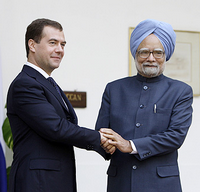India has recently seen a succession of visits by the top leaders of the permanent Security Council members. The British prime minister was in India in late July, and the American president came calling in early November. Visits by the French president and the Chinese premier followed earlier this month. In contrast to the high-profile U.S. visit, Russian President Dmitry Medvedev flew into India almost unnoticed on Dec. 21.
Although the Soviet Union was India's staunchest ally during the Cold War, India has drifted away from post-Cold War Russia. This stands in stark contrast to India's ties with the U.S., which have steadily rebounded from the fallout over India's 1998 nuclear tests to reach their apogee with the conclusion of the 2008 Indo-U.S. civil-nuclear deal. Despite the relative downgrade in the Indo-Russian relationship, however, Russia remains India's largest defense supplier, providing nearly 70 percent of India's weaponry.
Medvedev's visit to India kicked off with the two countries signing 30 deals in crucial areas like civil-nuclear cooperation and defense, including a fifth-generation fighter aircraft to be jointly designed and developed by India's Hindustan Aeronautics Ltd and Russia's Sukhoi Design Bureau and Rosoboronexport. The design contract is estimated to cost $295 million, and the Indian Air Force is likely to acquire as many as 300 of these aircraft by 2030.

